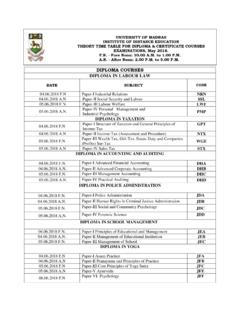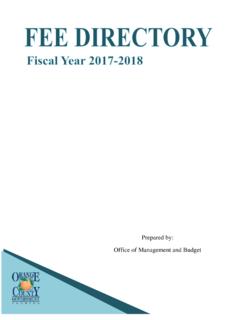Transcription of MSC Cyber Forencis & Information Security
1 1 UNIVERSITY OF MADRAS INSTITUTE OF DISTANCE EDUCATION MSC Cyber Forensics & Information Security Under Choice Based Credits System (With effect from the academic year 2018-2019) SCHEME OF EXAMINATION SEMESTER - I SUBJECTS CREDIT MAX MARKS TOTAL course COMPONENT INT EXT Core Paper-I Introduction to Cyber Criminology 4 20 80 100 Core Paper-II Networking and Communication Protocols 4 20 80 100 Core Paper-III Introduction to Information Security 4 20 80 100 Core Paper-IV IT Infrastructure and Cloud Computing 4 20 80 100 Elective Paper-I Forms of Cyber Crimes 3 20 80 100 SEMESTER -II SUBJECTS CREDIT MAX MARKS TOTAL course COMPONENT INT EXT Core Paper-V Network Security and Cryptography 4 20 80 100 Core Paper-VI Basics of Cyber Forensics 4 20 80 100 Core Paper-VII IT and Telecom Frauds & Countermeasures 4 20 80 100 Core Paper-VIII Practical- I (Networking and Information Security )
2 4 40 60 100 Elective Paper-II BFSI Frauds & Countermeasures 3 20 80 100 SEMESTER -III SUBJECTS CREDIT MAX MARKS TOTAL course COMPONENT INT EXT Core Paper- IX Database Management Security 4 20 80 100 Core Paper- X Advanced Cyber Forensics 4 20 80 100 Core Paper- XI Advanced Information Security 4 20 80 100 Core Paper- XII Practical II ( Cyber Forensics) 4 40 60 100 Elective Paper- III Data Privacy 3 20 80 100 SEMESTER IV SUBJECTS CREDIT MAX MARKS TOTAL course COMPONENT INT EXT Core Paper- XIII Application Security 4 20 80 100 Core Paper- XIV Governance, Risk &Compliance 4 20 80 100 Core Paper- XV Business Continuity & Disaster Recovery Management 4 20 80 100 Core Paper- XVI Security Testing 4 20 80 100 Elective Paper-IV Cyber Laws & Intellectual Property Rights 3 20 80 100 2 CREDIT DISTRIBUTION CREDITS Core Paper 16 X 4 56 Core Practical 2x4 08 Elective 4 X 3 12 TOTAL 76 MSC Cyber Forensics & Information Security Under Choice Based Credits System (With effect from the academic year 2018-2019) REVISED SYLLABUS SEMESTER I Core Paper I -Introduction to Cyber Criminology Unit 1.
3 Principles and Concepts of Cyber Criminology Crime, Tort, Misdemeanour, Cyber Space, Cyber Crime, Cyber Criminology, Information Security , Penetration Testing, Incident Response, GRC, Conventional crimes vs. Cyber Crimes. Unit 2: Contemporary Forms of Crimes - White Collar Crimes, Economic Offences, Organized Crimes, Terrorism, Crime and Media and other contemporary forms of crimes. Unit 3: Psychology of Cyber Criminals Types of Cyber Criminals Modus Operandi of Cyber Criminals Profiling of Cyber Criminals - Tools and Techniques adopted by Cyber Criminals Psychological theories relating to Cyber criminals. Unit 4 : Cyber Crime Sociological and Criminological Perspectives Causes of Cyber Crimes - Criminological Theories and Cyber Crime Routine Activity Theory, Social Learning Theory, Differential Association Theory, Differential Opportunity Theory, Media and Crime and latest theories and other related theories.
4 Unit 5: The Role of Criminal Justice Administration and Cyber Crimes : a. Police Organizational structure of Police in India Different wings in the States and Districts and their functions - Police & Law Enforcement cognizable and non-cognizable offences, bailable and non-bailable offences arrest , search, seizure Interrogation of suspects and witnesses charge sheet Cybercrime cells structure & investigation of cybercrime cases . b. Judiciary - Different types of courts Cyber Appellate Court / Tribunals / Powers Proceedings in the court before trial, after trial, plea of guilty, sentencing. c. The Role of in the Prevention of Cyber Crimes d. The Role of Victims of Cyber Crimes in the Criminal Justice Administration Crime Prevention - Crime and sense of Security - Social control and crime prevention - Community and crime prevention - Contemporary crime prevention strategies.
5 3 Core Paper II -Networking and Communication Protocols Unit 1 Networking models- OSI Layered model - TCP/IP Model - MAC Address representation - Organisationally Unique Identifier - Internet Protocol - Versions and Header lengths - IP Identification - IP Flags - IP fragmentation and reassembly structure - Transport Layer protocols - Port numbers - TCP Flags - Segmentation - TCP 3 way handshake and Options - encapsulation and De-encapsulation - Payload. Unit 2 Static and Dynamic Routing - IP Routing Protocols - Classful and Classless Routing - RIPv1 - RIPv2, Broadcast and Multicast domains - OSPF, EIGRP - Network Address Translation - IP Classes - Private IP - Public IP - Reserved IP - APIPA. Unit 3 Subnetting IP network - Class A, B, C subnetting - Classless Inter-domain Routing (CIDR) - Subnet mask - Wild card mask - WAN Technologies - Frame Relay - Data link Connection Identifiers (DLCI) - Committed Information Rate (CIR) - Permanent Virtual Circuits (PVCs) - Multiprotocol Label Switching (MPLS) - Edge Routers - Label Switching - CE and PE Routers - Data Terminal equipment (DTE) - Data Communication equipment (DCE) - Clock speed.
6 Unit 4 Virutal LANs - Access links and Trunk links - Switchport modes - Vlan Trunking - Server, Client and Transparent modes - VTP Domain - Configuration Revision numbers - Inter Vlan Communications - Broadcast domain - Collision Domain Unit 5 Communication protocols - Address Resolution Protocol (ARP) - Reverse Address Resolution Protocol (RARP) - Internet Control Message Protocol (ICMP) - Internet Protocol (IP) - Transmission Control Protocol (TCP) - User Datagram Protocol (UDP) - American Standard Code for Information Interchange (ASCII) - Hypertext Transfer Protocol (HTTP) - File Transfer Protocol (FTP) - Simple Mail Transfer Protocol (SMTP) - Telnet - Trivial File Transfer Protocol (TFTP) - Post Office Protocol version 3 (POP3) - Internet Message Access Protocol (IMAP) - Simple Network Management Protocol (SNMP) - Domain Name System (DNS) - DNS Flags - Dynamic Host Configuration Protocol (DHCP).
7 4 Core Paper III Introduction to Information Security Unit 1: Overview of Information Security - What is Information and why should be protect it? - Information Security - Threats - Frauds, Thefts, Malicious Hackers, Malicious Code, Denial-of-Services Attacks and Social Engineering - Vulnerability Types - Risk an introduction - Business Requirements - Information Security Definitions - Security Policies - Tier1 (Origination-Level), Tier2 (Function Level), Tier3 (Application/Device Level) Procedures - Standards - Guidelines Unit 2: Information Asset Classification - Why should we classify Information ? - Information Asset Owner, custodian , User - Information Classification - Secret, Confidential, Private and Public Methodology - Declassification or Reclassification - Retention and Disposal of Information Assets - Provide Authorization for Access Owner, custodian , User Unit 3: Risk Analysis & Risk Management - Risk Analysis Process - Asset Definition - Threat Identification - Determine Probability of Occurrence - Determine the Impact of the Threat - Controls Recommended - Risk Mitigation - Control Types/Categories - Cost/Benefit Analysis Unit 4.
8 Access Control - User Identity and Access Management - Account Authorization - Access and Privilege Management - System and Network Access Control - Operating Systems Access Controls - Monitoring Systems Access Controls - Intrusion Detection System - Event Logging - Cryptography Unit 5: Physical Security - Identify Assets to be Protected - Perimeter Security - Fire Prevention and Detection - Safe Disposal of Physical Assets. 5 Core Paper IV IT Infrastructure and Cloud Computing Unit 1: Computer Hardware Basics Basics of Motherboard including CMOS and BIOS Working of processors and types of processors System memory Introduction to RAM System storage devices o Types of hard disks - FAT, NTFS, RAID etc. o Optical drives o Removable storage devices o Tape drives and backup systems Common computer ports Serial Parallel - USB ports etc.
9 Different input systems - Key Board - Mouse etc. Display arrays VGA SVGA AGP Additional display cards Monitors and their types Printers and their types Unit 2: Operating Systems Operating system basics o Functions of operating system o Functions of Client Operating System o Functions of Server operating system o Introduction to Command line operation Basics on files and directories Details about system files and boot process Introduction to device drivers Unit 3: Computer Principles and a Back Box Model of the PC Memory and processor Address and data buses Stored program concept Physical components of the PC and how they fit together and interact Basic electrical safety Motherboards and the design of the PC Dismantling and re-building PCs Power On Self Test and boot sequence o Architecture of real mode o Interrupts o Start of boot sequence o Power On Self Test (POST) Unit 4.
10 Enterprise and Active Directory Infrastructure Overview of Enterprise Infrastructure Integration Requirement to understand the Enterprise Infrastructure 6 Enterprise Infrastructure Architecture and it s components Overview of Active Directory (AD) Kerberos LDAP Ticket Granting Ticket {TGT} Forest Domain Organization Unit (OU) Site Topology of a Forest Trust Relationships Object Creation, Modification, Management and Deletion o User o Group o Computer o OU o Domain Group Policy (GPO) Management o Structure of GPO o Permissions and Privileges o GPO Security Settings Password Settings Account Lockout Settings Account Timeout Settings USB Enable/ Disable Settings Screen Saver Settings Audit Logging Settings Windows Update Settings User Restriction Settings o Creation of GPO o Linking a GPO o Application of GPO Linking a GPO Enforcing a GPO GPO Status Inclusion / Exclusion of Users/ Groups in a GPO o Precedence of GPO o Loopback Processing of GPO o Fine-Grain Policy / Fine-Grain Password Policy Addition of Windows Workstations to Domain and Group Policy Synchronisation Addition of Non-Windows Workstations in AD Environment Integrating Finger-Print, Smart Card.










